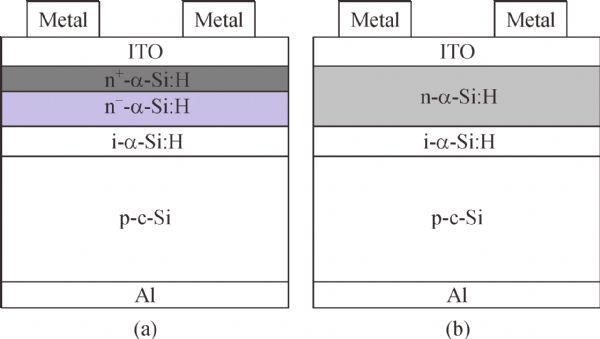

Analysis of the double-layer α-Si:H emitter with different doping concentrations for α-Si:H/c-Si heterojunction solar cells
Received date: 02 Aug 2016
Accepted date: 14 Sep 2016
Published date: 16 Nov 2016
Copyright
Double-layer emitters with different doping concentrations (DLE) have been designed and prepared for amorphous silicon/crystalline silicon (α-Si:H/c-Si) heterojunction solar cells. Compared with the traditional single layer emitter, both the experiment and the simulation (AFORS-HET, http://www.paper.edu.cn/html/releasepaper/2014/04/282/) prove that the double-layer emitter increases the short circuit current of the cells significantly. Based on the quantum efficiency (QE) results and the current-voltage-temperature analysis, the mechanism for the experimental results above has been investigated. The possible reasons for the increased current include the enhancement of the QE in the short wavelength range, the increase of the tunneling probability of the current transport and the decrease of the activation energy of the emitter layers.

Haibin HUANG , Gangyu TIAN , Tao WANG , Chao GAO , Jiren YUAN , Zhihao YUE , Lang ZHOU . Analysis of the double-layer α-Si:H emitter with different doping concentrations for α-Si:H/c-Si heterojunction solar cells[J]. Frontiers in Energy, 2017 , 11(1) : 92 -95 . DOI: 10.1007/s11708-016-0432-8
| 1 |
Tanaka M, Taguchi M, Matsuyama T, Sawada T, Tsuda S, Nakano S, Hanafusa H, Kuwano Y. Development of new α-Si/c-Si heterojunction solar cells: ACJ-HIT (Artificially Constructed Junction-Heterojunction with Intrinsic Thin-Layer). Japanese Journal of Applied Physics, 1992, 31(11): 3518–3522
|
| 2 |
Sawada T, Terada N, Tsuge S, Baba T, Takahama T, Wakisaka K, Tsuda S, Nakano S. High-efficiency α-Si/c-Si heterojunction solar cell. Conference Record of IEEE Phot. Spec. Conf., 1994, 2(2): 1219–1226
|
| 3 |
Gifford J. Panasonic hits 24.7% cell efficiency. 2013–04
|
| 4 |
Wünsch F, Citarella G, Abdallah O, Kunst M J. An inverted a-Si:H/c-Si hetero-junction for solar energy conversion. Journal of Non-Crystalline Solids, 2006, 352(9-20): 1962–1966
|
| 5 |
Johnson J N, Manivannan V. Photovoltaic device which includes all-back-contact configuration and related fabrication process. US Patent: 2008/0000522 A1, 2008–01–03
|
| 6 |
Terakawa A, Asaumi T. Photovoltaic cell and method of fabricating the same. US Patent: 20050062041A1, 2005–03–24
|
| 7 |
Zhang L, Shen H L, Yue Z H, Jiang F, Wu T R, Pan Y Y. Effect of emitter layer doping concentration on the performance of silicon thin film heterojunction solar cell. Chinese Physics B, 2013, 22(1): 016803
|
| 8 |
Fossum J G, Lindholm F A, Sah C T. Physics underlying improved efficiency of high-low-junction emittersilicon solar cells. International Electronic Devices Meeting, 1977, 23: 222–225
|
| 9 |
Zouari A, Arab A B. Effect of the front surface field on crystalline silicon solar cell efficiency. Renewable Energy, 2011, 36(6): 1663–1670
|
| 10 |
Zhong S, Hua X, Shen W. Simulation of high-efficiency crystalline silicon solar cells with homo–hetero junctions. IEEE Transactions on Electron Devices Year, 2013, 60(7): 2104–2110
|
| 11 |
Huang H B, Gao J, Fahrner W R, Zhou L. Theoretical analysis of the double-layer emitter with different doping concentrations for α-Si:H/c-Si heterojunction solar cells. 2014
|
| 12 |
Suzue K, Mohammad S N, Fan Z F, Kim W, Aktas O, Botchkarev A E, Morkoç H. Electrical conduction in platinum-gallium nitride Schottky diodes. Journal of Applied Physics, 1996, 80(8): 4467–4478
|
/
| 〈 |
|
〉 |